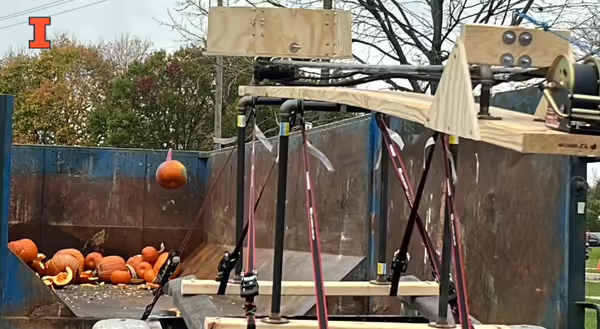
From decorating and carving pumpkins to visiting a pumpkin patch, pumpkins bring excitement during the fall season for people of all ages. Carving jack-o’-lanterns is a common tradition amongst families for fall fun, but where should they go after they start to deteriorate? Pumpkins thrown into landfills are never broken down and release greenhouse gases, accounting for over one billion pumpkins thrown out every year (EPA 2024). Instead, consider composting them at home or attending a Pumpkin Smash event near you, where pumpkins are composted with a local waste hauler after the family fun event.
Pumpkins are cucurbits, which are water-based crops that provide excellent organic matter for compost piles. Compost is a natural-based product that acts as a beneficial soil amendment, commonly used in home gardens and small farms. Plant-based compost is a good addition to gardens as it utilizes plant materials to distribute nutrients to the soil before or during crop planting. Smashing pumpkins encourages plant materials to break down and degrade before they are added to a compost pile. With Illinois being the largest pumpkin producer in the nation (Johanning 2020), that accounts for about 690 million pounds of pumpkins each year, which highlights the importance of safely disposing of pumpkins after Halloween.
What Your Family Can Do
Make sure to remove any decorations, paint, or non-compostable materials from pumpkins before attending a Pumpkin Smash event. These events are a great way to dispose of pumpkins safely, offering an opportunity to compost them locally. There are other ways to dispose of pumpkins if pumpkin smash events are not occurring near you:
Add them to your own compost pile; at-home compost can decrease an individual’s carbon footprint and provide compost for home gardens
Do NOT toss or leave pumpkins in forest preserves or ditches, as this is considered littering and can be illegal. (Enroth and Steele 2022).
Do Not Feed Pumpkins to Wildlife
The Illinois Department of Natural Resources does not recommend feeding pumpkins to wildlife, as it can lead to damage complaints, as well as the spread of disease, such as Chronic Wasting Disease in deer and powdery mildew on plant debris. Except for bird and squirrel feeders near a residence, it is illegal to provide food, salt, mineral blocks, or other products for deer and other wildlife to eat, it is considered dangerous. Every fall, the University of Illinois Wildlife Medical Clinic treats wild animals that get trapped or tangled in decorative items left on holiday decorations (Enroth and Steele 2022).
Do not give gourds washed with bleach to farm animals since it is toxic. A white vinegar solution is a safe alternative but will not be effective if the pumpkin is already showing signs of molding. For more information about the effects of pumpkins on wildlife and forests, reach out to your local Extension office for tips and advice for safely disposing of pumpkins.
How do you enjoy pumpkins in the fall? Do you have an environmentally safe way to dispose of them? Illinois grows about 690 million pounds of pumpkins every year (USDA-ERS 2025). That is a lot of waste in the landfills! To combat this, find a pumpkin smash event near you through Scarce and Illinois Extension, don’t trash it, smash it!
References:
Enroth C., Steele E. 2022. The University of Illinois Extension. Don’t dump Halloween pumpkins, donate or compost them. https://extension.illinois.edu/news-releases/dont-dump-halloween-pumpkins-donate-or-compost-them [accessed 20 October 2025].
Johanning, N. 2020. The University of Illinois Extension. Illinois Leads U.S. in Pumpkin Production. https://extension.illinois.edu/news-releases/illinois-leads-us-pumpkin-production [Accessed 21 October 2025].
USDA-ERS. 2025. Pumpkins: Background & Statistics. https://www.ers.usda.gov/newsroom/trending-topics/pumpkins-background-statistics [Accessed 22 October 2025].